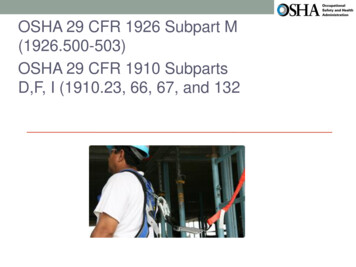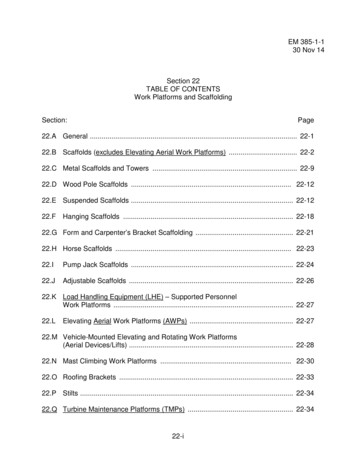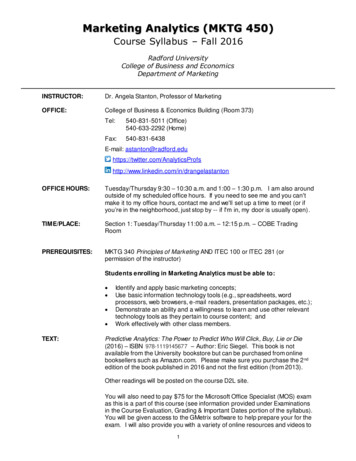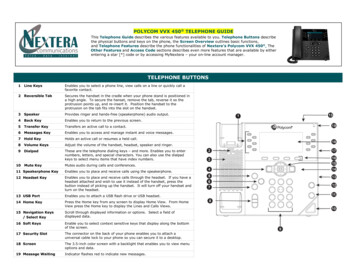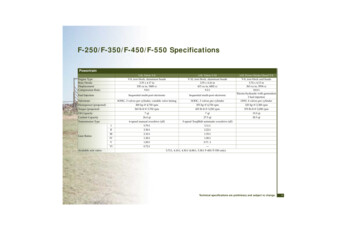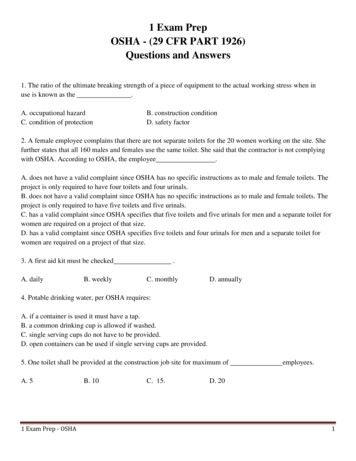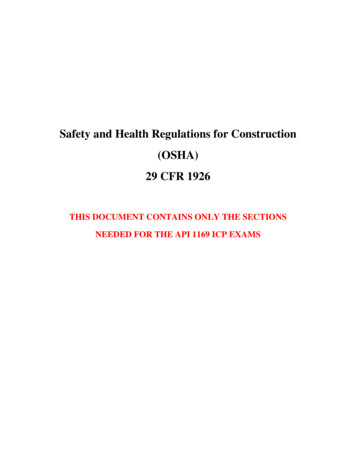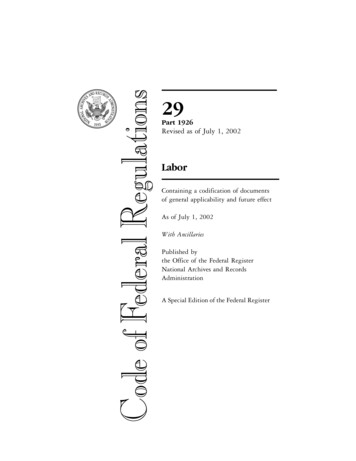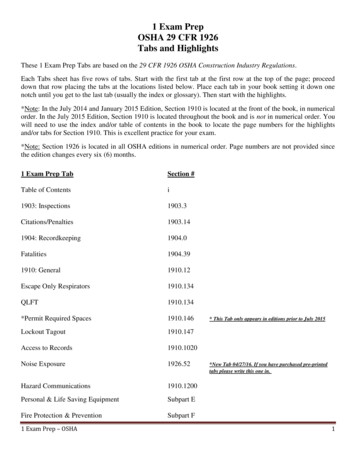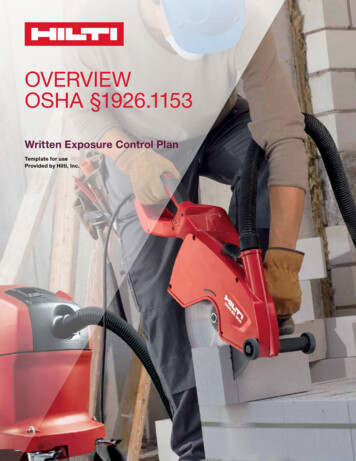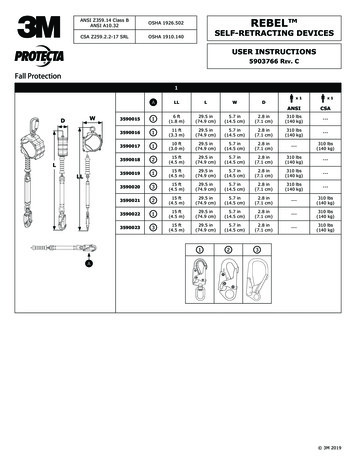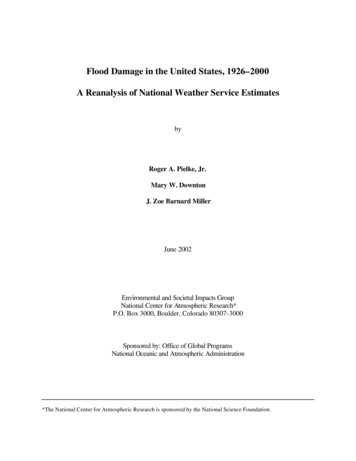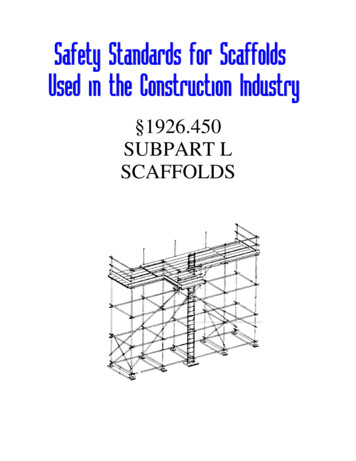
Transcription
§1926.450SUBPART LSCAFFOLDS
Safety Standards for ScaffoldsUsed in the Construction IndustrySUMMARYThe Occupational Safety and Health Administration(OSHA) hereby revises theconstruction industry safety standards which regulate the design, construction, and useof scaffolds. The final rule updates the existing scaffold standards and setsperformance-oriented criteria, where possible, to protect employees from scaffoldrelated hazards such as falls, falling objects, structural instability, electrocution andoverloading.In particular, the final rule has been updated to address types of scaffolds -- such ascatenary scaffolds, step and trestle ladder scaffolds, and multi-level suspendedscaffolds -- not covered by OSHA's existing scaffold standards. In addition, the finalrule allows employers greater flexibility in the use of fall protection systems to protectemployees working on scaffolds and extends fall protection to erectors and dismantlersof scaffolds to the extent feasible.Another area that the final rule strengthens is training for workers using scaffolds; theconditions under which such employees must be retrained are also specified in the finalrule. Finally, the language of the rule has been simplified, duplicative and outdatedprovisions have been eliminated, overlapping requirements have been consolidated,and the performance orientation of the rule has been enhanced to allow employers asmuch flexibility in compliance as is consistent with employee protection.EFFECTIVE DATESThis standard will become effective on November 29, 1996, except for§1926.453(a)(2), which will not become effective until an Office of Management andBudget (OMB) Control number is received and displayed for this "collection ofinformation" in accordance with the Paperwork Reduction Act of 1995 (44 U.S.C. 3501et seq.).The incorporations by reference of certain publications listed in this final rule areapproved by the Director of the Federal Register as of November 29, 1996. Inaddition, employers are required to comply with the provisions of paragraphs (e)(9) and(g)(2) of §1926.451, which address safe access and fall protection, respectively, foremployees erecting and dismantling supported scaffolds starting on September 2,1997.2
I. BackgroundCongress amended the Contract Work Hours Standards Act in 1969 by adding a newsection 107 to provide employees in the construction industry with a safer workenvironment and to reduce the frequency and severity of construction accidents andinjuries. The amendment, commonly known as the Construction Safety Act (CSA),significantly strengthened employee protection by authorizing the promulgation ofconstruction safety and health standards for employees of the building trades andconstruction industry working on federal and federally-financed or federally-assistedconstruction projects.The Occupational Safety and Health Act of 1970 (the OSH Act) authorized theSecretary of Labor to adopt established federal standards issued under other statutes,including the CSA, as occupational safety and health standards. Accordingly, theSecretary of Labor adopted the Construction Standards, which had been issued underthe CSA, as OSHA standards. The Safety and Health Regulations for Constructionwere subsequently redesignated as 29 CFR part 1926. Standards addressing scaffolds, §§1926.451 and 1926.452, were adopted in subpart L of part 1926 as OSHAstandards as part of this process.Various amendments were made to subpart L during the first two years of the OSH Act.The amendments revised scaffold provisions that addressed planking grades, woodpole scaffold construction, overhead protection, bracket scaffold loading, and plankspans. Also, substantive provisions concerning pump jack scaffolds, height of catchplatforms, and guardrails were added.Based on concerns regarding the effectiveness of the existing scaffold standards,OSHA began a complete review of subpart L in 1977. The Agency consulted theAdvisory Committee on Construction Safety and Health (ACCSH) several timesregarding draft revisions to subpart L.Based on its review of existing subpart L, OSHA believes that certain provisions in theexisting standards are outdated, redundant, or ambiguous. In addition, some types ofscaffolds used in construction (e.g., catenary scaffolds) are not clearly addressed bythe existing standards, and some provisions cover only certain types of scaffolds whenthey should apply to all. The final rule eliminates those unnecessary, outdated andredundant provisions (e.g., revised subpart L states the requirement for guardrailsonce, rather than 19 separate times as in the existing standard).3
II. Hazards InvolvedScaffold-related incidents resulting in injuries and fatalities continue to occur despite thefact that OSHA has had a scaffold standard in place since 1971. However, the Agencybelieves that compliance with the new standard will be better than it has been in thepast because this standard has been simplified, brought up to date, and strengthenedto provide additional protection.Although specific accident ratios cannot be projected for the estimated 3.6 millionconstruction workers currently covered by subpart L, the Economic Analysis thataccompanies this final rule estimates that, of the 510,500 injuries and illnesses thatoccur in the construction industry annually, 9,750 are related to scaffolds. In addition,of the estimated 924 occupational fatalities occurring annually, at least 79 areassociated with work on scaffolds.OSHA prepared the following statistical estimates (based on 4.5 million constructionworkers then covered by subpart L) to support the 1986 proposal for subpart L, basedon a review of accident data prepared by the Bureau of Labor Statistics (BLS) (Ex. 3-1).The revised scaffold standards contain a number of provisions designed specifically toaddress the findings of this analysis.a. Seventy-two percent of the workers injured in scaffold accidents covered bythe BLS study attributed the accident either to the planking or support giving way, or tothe employee slipping, or being struck by a falling object. Plank slippage was the mostcommonly cited cause.b. About 70 percent of the workers learned of the safety requirements forinstalling work platforms, assembling scaffolds, and inspecting scaffolds through onthe-job training. Approximately 25 percent had no training in these areas.c. Only 33 percent of scaffolds were equipped with a guardrail.Based on its analysis of the available data and its field experience in enforcingconstruction standards, the Agency has determined that employees using scaffolds areexposed to a significant risk of harm. Specifically, scaffold related fatalities still accountfor approximately 9% of all fatalities in the construction workplace.In addition, the above data indicate that the revised final standard would haveprevented many of these accidents more effectively than compliance with the existingscaffold standards. Consequently, OSHA finds that the revision of its scaffoldstandards for construction is necessary to improve employee protection. OSHA hasdetermined that, as revised, the standard clearly states employers' duties and theappropriate compliance measures.4
III. Summary and Explanation of the Final RuleThe following explains how the final rule corresponds to or differs from the existingstandard.§1926.450 Scope, application and definitions applicable to this subpart.Paragraph (a) The final rule applies to all scaffolds used in construction, alteration,repair (including painting and decorating), and demolition operations covered under 29CFR part 1926, except that crane or derrick suspended personnel platforms willcontinue to be regulated under §1926.550(g). In addition, aerial lifts are coveredexclusively in §1926.453, as noted in paragraph (a) of §1926.450.OSHA will continue to regulate temporary elevated work platforms, such as false carsand go-devils used in elevator shaft construction, as scaffolds.Paragraph (b) of §1926.450 lists and defines all major terms used in subpart L.OSHA is revising its definitions for particular types of scaffolds by specifying whether aparticular type of scaffold is a "supported" or a "suspension scaffold." OSHA believesthat adding this information will make it easier for employers to identify the appropriategeneral requirements in final rule §1926.451.The Agency has also revised subpart L definitions by deleting language that limits theuse of a particular type of scaffold. Such substantive limitations are more appropriatelyplaced in regulatory text. Accordingly, for example, OSHA has revised the definition for"bricklayers' square scaffolds" (a scaffold composed of framed wood squares whichsupport a platform, limited to light and medium duty) by deleting the words "limited tolight and medium duty". Similarly, OSHA has revised the definition for "coupler" to be"a device for locking together the component tubes of a tube and coupler scaffold",deleting language addressing the material used for the coupler because suchrequirements are more properly located in §§1926.451 or 1926.452.Paragraph 1926.451(a) CapacityParagraph (a) sets the minimum strength criteria for all scaffold components andconnections. The final rule sets scaffold capacity requirements that are substantivelythe same as those in existing subpart L, while eliminating ambiguities and apparentinconsistencies.5
Paragraph (a)(1) requires that each scaffold and scaffold component be capable ofsupporting, without failure, its own weight and at least 4 times the maximum intendedload applied or transmitted to it. Paragraphs (a)(2), (a)(3), (a)(4), (a)(5) and (g) of§1926.451 provide exceptions to this general rule, and are discussed below.The final rule clearly provides that the 4 to 1 factor for a component applies only to theload which is actually applied or transmitted to that component, and not to the total loadplaced on the scaffold. The Agency requires that each component be adequate tomeet the 4 to 1 factor, but only for the portion of the MIL applied or transmitted to thatcomponent. The MIL for each component depends on the type and configuration of thescaffold system.Paragraph (a)(2) requires that direct connections to roofs and floors andcounterweights used to balance adjustable suspension scaffolds be capable of resistingat least 4 times the tipping moment imposed by the scaffold operating at the rated loadof the UL rated hoist or at 1.5 (minimum) times the tipping moment imposed by thescaffold operating at the stall load for hoist not UL rated, whichever is greater.OSHA agrees that the safety factors for the counterweights, riggings, direct connectionsto roofs and floors, and suspension ropes of adjustable suspension scaffolds should berelated to the rated load of the hoist and the stall load of the hoist, and not be based onthe maximum intended load.Paragraph (a)(3) provides that "each suspension rope, including its connectinghardware, used on non-adjustable suspension scaffolds shall be capable of supporting,without failure, at least 6 times the maximum intended load applied or transmitted tothat rope."Paragraph (a)(4) of the final rule provides that "each suspension rope, includingconnecting hardware, used on adjustable suspension scaffolds shall be capable ofsupporting, without failure, at least 6 times the maximum intended load applied ortransmitted to that rope with the scaffold operating at either (a) the rated load of thehoist, or (b) 2 (minimum) times the stall load of the hoist, whichever is greater".Paragraph (a)(5) requires that the stall load of any scaffold hoist not exceed 3 times itsrated load. OSHA finds that this requirement is reasonably necessary to preventaccidental overloading of suspension scaffold support systems. U.L. standard 1323limits the output force of a scaffold hoist to three times the rated load of the hoist. Asfar as OSHA has been able to determine, the other laboratories which test and listscaffold hoists adhere to the requirements of U.L. 1323.Paragraph (a)(6) requires that scaffolds be designed by a qualified person andconstructed and loaded in accordance with that design.6
Paragraph 1926.451(b) Scaffold Platform ConstructionParagraph 1926.451(b) provides criteria for the construction of scaffolds.Paragraph (b)(1) requires all platforms, except walkways and those platforms used byemployees performing scaffold erection and dismantling operations, to be fully deckedor planked.Paragraph (b)(1)(I) requires that platform units be placed so that spaces between unitsdo not exceed 1-inch, except where employers establish that more space is needed.For example, this would be necessary to fit around uprights when using side bracketsto extend platform width.Paragraph (b)(1)(ii) provides that, where the exception created by paragraph (b)(1)(I)applies, employers shall place platform units as close together as possible, with thespace between the platform and uprights not to exceed 9½ inches. OSHA set 9½inches as the maximum space allowed, because the minimum width for scaffold unitsthat could be expected to sustain a working load is just over 9½ inches.In a situation where no work, other than erecting or dismantling the scaffold, is beingdone at intermediate levels, the final rule requires only that the planking established bythe employer as necessary to provide safe working conditions for employees erectingor dismantling the scaffold be used. On the other hand, if scaffold erection ordismantling is being performed from an intermediate level platform that is being or willbe used as a work area, that platform must be fully planked in accordance withparagraph (b)(1).The Agency believes that platforms used solely as walkways or solely by employeeserecting or dismantling scaffolds should be at least 2 planks wide. This is consistentwith the current practice, and the requirements of §1926.451(b)(2).Paragraph (b)(2) requires that all scaffold platforms and walkways be at least 18inches (4
folds, §§1926.451 and 1926.452, were adopted in subpart L of part 1926 as OSHA standards as part of this process. Various amendments were made to subpart L during the first two years of the OSH Act. The amendments revised scaffold provisions that addressed planking grades, wood pole scaffold construction, overhead protection, bracket scaffold loading, and plank spans. Also, substantive .
